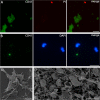The initial inflammatory response to bioactive implants is characterized by NETosis
- PMID: 25798949
- PMCID: PMC4370506
- DOI: 10.1371/journal.pone.0121359
The initial inflammatory response to bioactive implants is characterized by NETosis
Abstract
Implants trigger an inflammatory response, which is important for osseointegration. Here we studied neutrophil extracellular trap (NET) release of human neutrophils in response to sandblasted large-grit acid etched (SLA) implants using fluorescent, confocal laser scanning and scanning electron microscopy. Our studies demonstrate that human neutrophils rapidly adhered to SLA surfaces, which triggered histone citrullination and NET release. Further studies showed that albumin or acetylsalicylic acid had no significant effects on the inflammatory response to SLA surfaces. In contrast to bioinert materials, which do not osseointegrate, the bioactivity of SLA surfaces is coupled with the ability to release NETs. Further investigations are necessary for clarifying the role of NETosis for osseointegration.
Conflict of interest statement
Figures





Similar articles
-
Lipopolysaccharide-induced neutrophil extracellular trap formation in canine neutrophils is dependent on histone H3 citrullination by peptidylarginine deiminase.Vet Immunol Immunopathol. 2017 Dec;193-194:29-37. doi: 10.1016/j.vetimm.2017.10.002. Epub 2017 Oct 20. Vet Immunol Immunopathol. 2017. PMID: 29129225
-
Leukocytes coincubated with human sperm trigger classic neutrophil extracellular traps formation, reducing sperm motility.Fertil Steril. 2016 Oct;106(5):1053-1060.e1. doi: 10.1016/j.fertnstert.2016.06.005. Epub 2016 Jun 23. Fertil Steril. 2016. PMID: 27344301
-
Fibrinogen protects neutrophils from the cytotoxic effects of histones and delays neutrophil extracellular trap formation induced by ionomycin.Sci Rep. 2020 Jul 16;10(1):11694. doi: 10.1038/s41598-020-68584-0. Sci Rep. 2020. PMID: 32678135 Free PMC article.
-
Nanomaterial Exposure Induced Neutrophil Extracellular Traps: A New Target in Inflammation and Innate Immunity.J Immunol Res. 2019 Feb 28;2019:3560180. doi: 10.1155/2019/3560180. eCollection 2019. J Immunol Res. 2019. PMID: 30944832 Free PMC article. Review.
-
Neutrophil extracellular traps: mechanisms of formation and role in health and disease.Biochemistry (Mosc). 2014 Dec;79(12):1286-96. doi: 10.1134/S0006297914120025. Biochemistry (Mosc). 2014. PMID: 25716722 Review.
Cited by
-
Antibacterial Designs for Implantable Medical Devices: Evolutions and Challenges.J Funct Biomater. 2022 Jun 21;13(3):86. doi: 10.3390/jfb13030086. J Funct Biomater. 2022. PMID: 35893454 Free PMC article. Review.
-
Engineering antibacterial bioceramics: Design principles and mechanisms of action.Mater Today Bio. 2024 Apr 27;26:101069. doi: 10.1016/j.mtbio.2024.101069. eCollection 2024 Jun. Mater Today Bio. 2024. PMID: 38765246 Free PMC article. Review.
-
A systematic review on neutrophils interactions with titanium and zirconia surfaces: Evidence from in vitro studies.Clin Exp Dent Res. 2022 Aug;8(4):950-958. doi: 10.1002/cre2.582. Epub 2022 May 10. Clin Exp Dent Res. 2022. PMID: 35535662 Free PMC article.
-
Micrococcal Nuclease stimulates Staphylococcus aureus Biofilm Formation in a Murine Implant Infection Model.Front Cell Infect Microbiol. 2022 Jan 17;11:799845. doi: 10.3389/fcimb.2021.799845. eCollection 2021. Front Cell Infect Microbiol. 2022. PMID: 35111695 Free PMC article.
-
Janus-Faced Neutrophil Extracellular Traps in Periodontitis.Front Immunol. 2017 Oct 26;8:1404. doi: 10.3389/fimmu.2017.01404. eCollection 2017. Front Immunol. 2017. PMID: 29123528 Free PMC article. Review.
References
-
- Donath K, Laass M, Günzl HJ. The histopathology of different foreign-body reactions in oral soft tissue and bone tissue. Virchows Arch A Pathol Anat Histopathol. 1992;420: 131–137. - PubMed
-
- Berglundh T, Abrahamsson I, Lang NP, Lindhe J. De novo alveolar bone formation adjacent to endosseous implants. Clin Oral Implants Res. 2003;14: 251–262. - PubMed
-
- Eriksson C, Nygren H. The initial reactions of graphite and gold with blood. J Biomed Mater Res. 1997;37: 130–136. - PubMed
-
- Eriksson C, Blomberg E, Claesson P, Nygren H. Reactions of two hydrophilic surfaces with detergents, protein and whole human blood. Colloids Surf B Biointerfaces. 1997;9: 67–79. 10.1016/S0927-7765(97)00010-6 - DOI
Publication types
MeSH terms
Substances
LinkOut - more resources
Full Text Sources
Other Literature Sources
Miscellaneous

